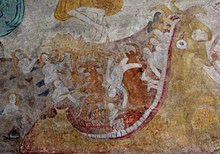Mot (god)
This article includes a list of references, but its sources remain unclear because it has insufficient inline citations. (January 2011) (Learn how and when to remove this template message) |
| Mot | |
|---|---|
Death and the Underworld | |
 Medieval depiction of Hell personified as fearsome monster, based on Old Testament descriptions of Mot. | |
| Major cult center | Ugarit |
| Equivalents | |
| Greek equivalent | Hades |
| Roman equivalent | Pluto |
Mot (Phoenician: 𐤌𐤕 mūt, Hebrew: מות māweṯ, Arabic: موت mawt) was the ancient Canaanite god of death and the Underworld. He was worshipped by the people of Ugarit, by the Phoenicians, and also by the Hebrews of the Old Testament. The main source of information about his role in Canaanite mythology comes from the texts discovered at Ugarit, but he is also mentioned in the surviving fragments of Philo of Byblos's Greek translation of the writings of the Phoenician Sanchuniathon and also in various books of the Old Testament.
Forms of the name[edit]
In Ugaritic myth, Mot (spelled mt) is a personification of death. The word is cognate with forms meaning 'death' in other Semitic and Afro-Asiatic languages: with Arabic موت mawt; with Hebrew מות (mot or mavet; ancient Hebrew muth or maveth/maweth); with Maltese mewt; with Syriac mautā; with Ge'ez mot; with Canaanite, Egyptian, Berber, Aramaic, Nabataean, and Palmyrene מות (mwt); with Jewish Aramaic, Christian Palestinian Aramaic, and Samaritan מותא (mwt’); with Mandaean muta; with Akkadian mūtu; with Hausa mutuwa; and with Angas mut.
Religion and mythology[edit]
Ugaritic texts[edit]
The main source of the story of Mot 'Death' is Ugaritic.[1][2] He is a son of 'El, and according to instructions given by the god Hadad (Ba'al) to his messengers, lives in a city named hmry ('Mirey'), a pit is his throne, and Filth is the land of her heritage. But Ba'al warns them:
that you not come near to divine Death,
lest he made you like a lamb in his mouth,
(and) you both be carried away like a kid in the breach of his windpipe.
Hadad seems to be urging that Mot come to his feast and submit himself to Hadad.
Death sends back a message that his appetite is that of lions in the wilderness, like the longing of dolphins in the sea and he threatens to devour Ba'al himself. In a subsequent passage Death seemingly makes good his threat, or at least is deceived into believing he has slain Ba'al. Numerous gaps in the text make this portion of the tale obscure. The sun stops shining as its goddess Shapash joins Ba'al's sister 'Anat in burying him. 'Anat then comes upon Mot, seizing him, splitting him with a blade, winnowing him in a sieve, burning him in a fire, grinding him under a millstone, and throwing what remains in the end over a field for birds to devour.
El, Baal's father, dreams that Baal is alive, and sends Shapash to bring him back to life because the land had become dry.
After seven years, Death returns, seeking vengeance and demanding one of Ba'al's brothers to feed upon. A gap in the text is followed by Mot complaining that Ba'al has given Mot his own brothers to eat, the sons of his mother to consume. A single combat between the two breaks out until the sun goddess Shapash upbraids Mot, informing him that his own father El will turn against him and overturn his throne if he continues. Mot concedes and the conflict ends.
Phoenician sources[edit]
A Phoenician account survives in a paraphrase of the Greek author Philo of Byblos by Eusebius,[3] who writes of a Phoenician historian named Sanchuniathon. In this account Death is a son of 'El and counted as a god, as the text says in speaking of 'El/Cronus:
And not long after another of his sons by Rhea, named Muth, having died, he deifies him, and the Phoenicians call him Thanatos ['Death'] and Pluto.
But earlier in a philosophical creation myth Sanchuniathon has referred to great wind which merged with its parents and that connection was called 'Desire' (πόθος):
From its connection Mot was produced, which some say is mud, and others a putrescence of watery compound; and out of this came every germ of creation, and the generation of the universe. So there were certain animals which had no sensation, and out of them grew intelligent animals, and were called "Zophasemin", that is "observers of heaven"; and they were formed like the shape of an egg. Also Mot burst forth into light, and sun, and moon, and stars, and the great constellations.
The form Mot (Μώτ) here is not the same as Muth (Μοὺθ) which appears later.
Hebrew scriptures[edit]
In Hebrew scriptures, Death ("Maweth/Mavet(h)") is sometimes personified as a devil or angel of death (e.g., Habakkuk 2:5; Job 18:13).[4] In both the Book of Hosea and the Book of Jeremiah, Maweth/Mot is mentioned as a deity to whom Yahweh can turn over Judah as punishment for worshiping other gods.[5]
See also[edit]
References[edit]
- ^ Ben Sasson, Haim Hillel (1976). A History of the Jewish People. Cambridge, MA: Harvard University Press. pp. 11–12. OCLC 3103763.
- ^ Cassuto, U. (1962). "Baal and Mot in the Ugaritic Texts". Israel Exploration Journal. 12 (2). JSTOR 27924890.
- ^ Eusebius of Caesarea, Praeparatio Evangelica, Book 1, chap. 9–10, trans. E. H. Gifford (1903) http://www.tertullian.org/fathers/eusebius_pe_01_book1.htm
- ^ Cassuto, U. (1962). "Baal and Mot in the Ugaritic Texts". Israel Exploration Journal. 12 (2): 81–83. JSTOR 27924890.
- ^ Handy, Lowell (1995). The Appearance of the Pantheon in Judah in The Triumph of Elohim. Grand Rapids, Michigan: Eerdmans. pp. 40. ISBN 0-8028-4161-9.
External links[edit]
- Putting God on Trial- The Biblical Book of Job A Biblical reworking of the combat motif between Mot and Baal.
- Book 1 of the Praeparatio Evangelica of Eusebius containing the paraphrase of Philo